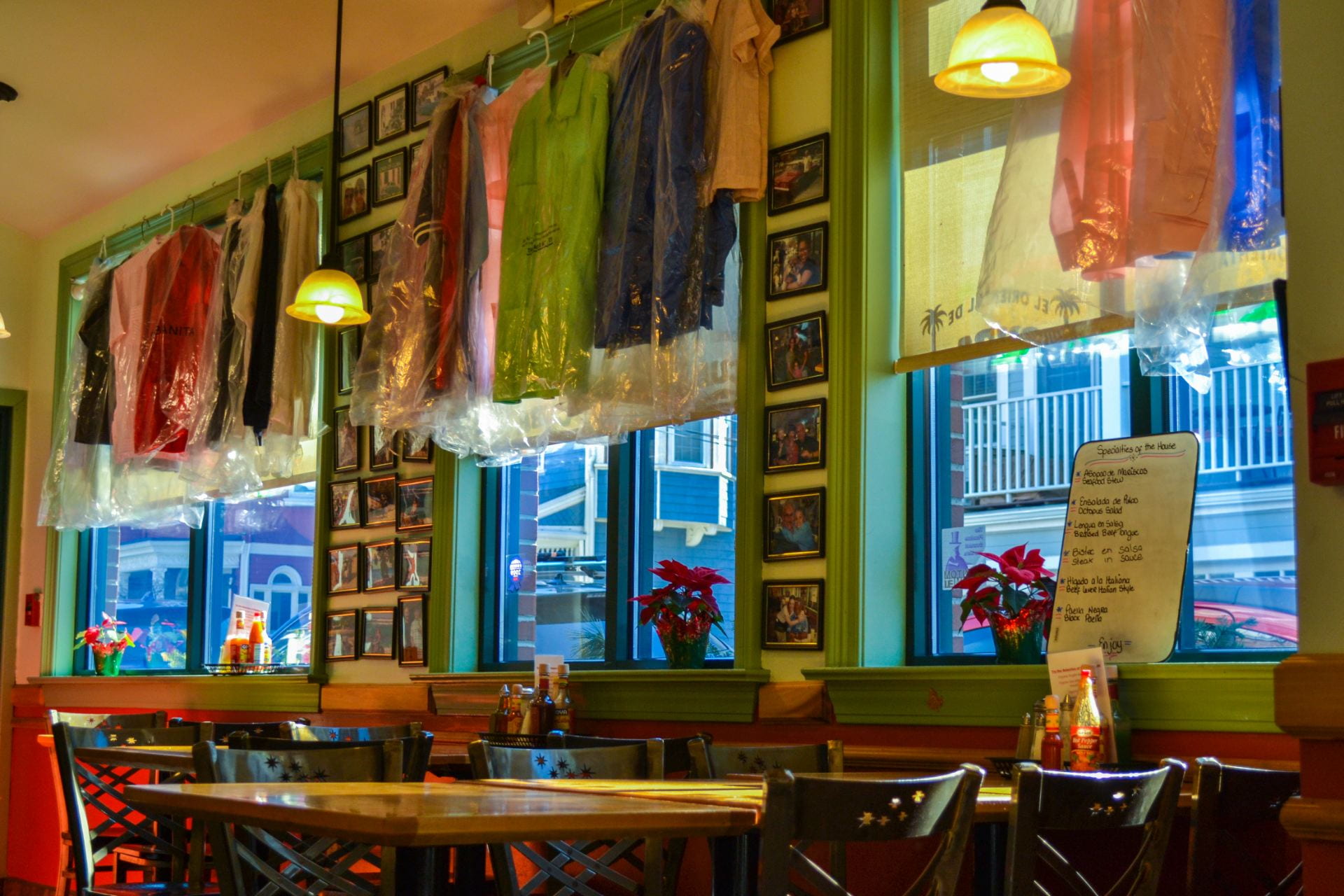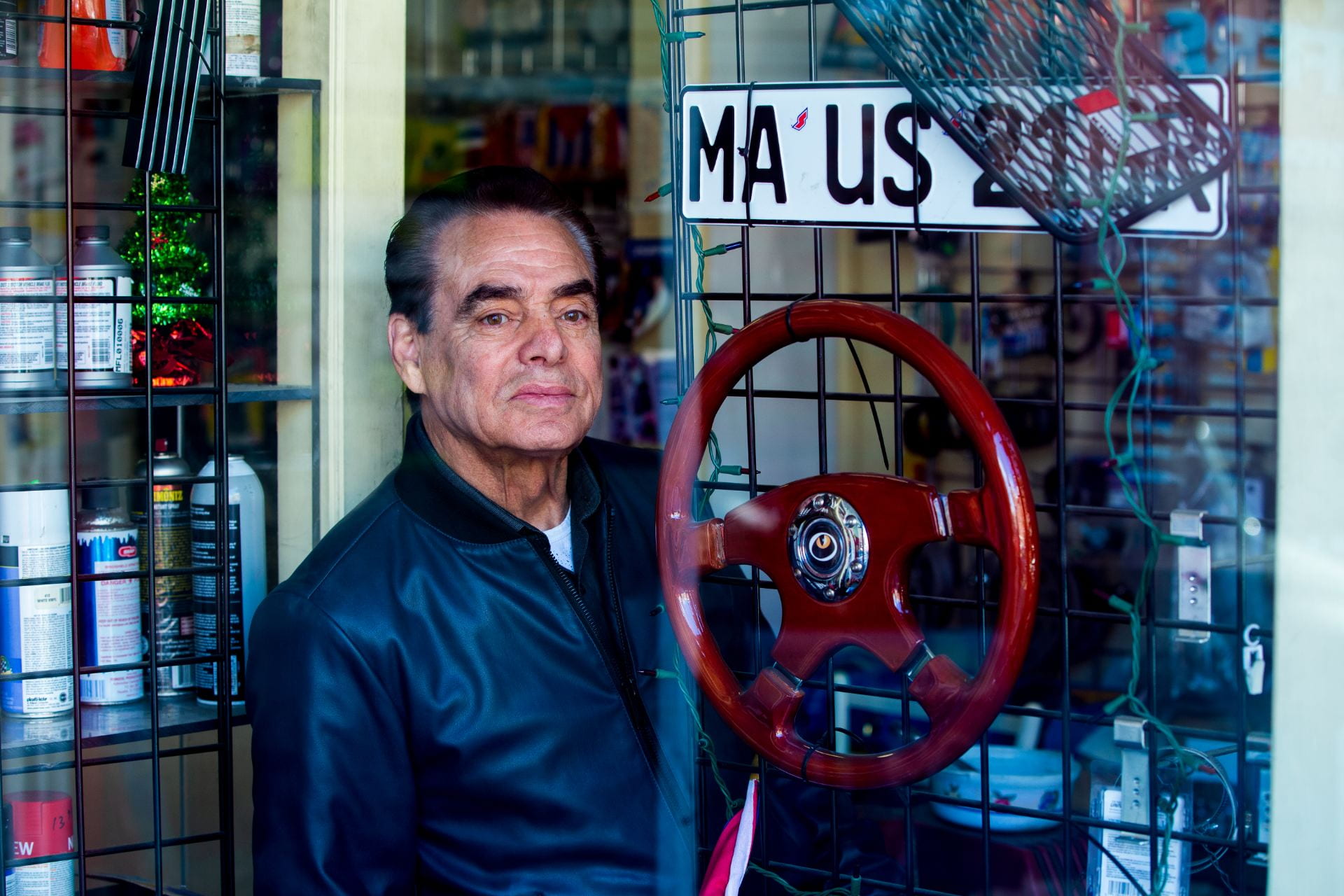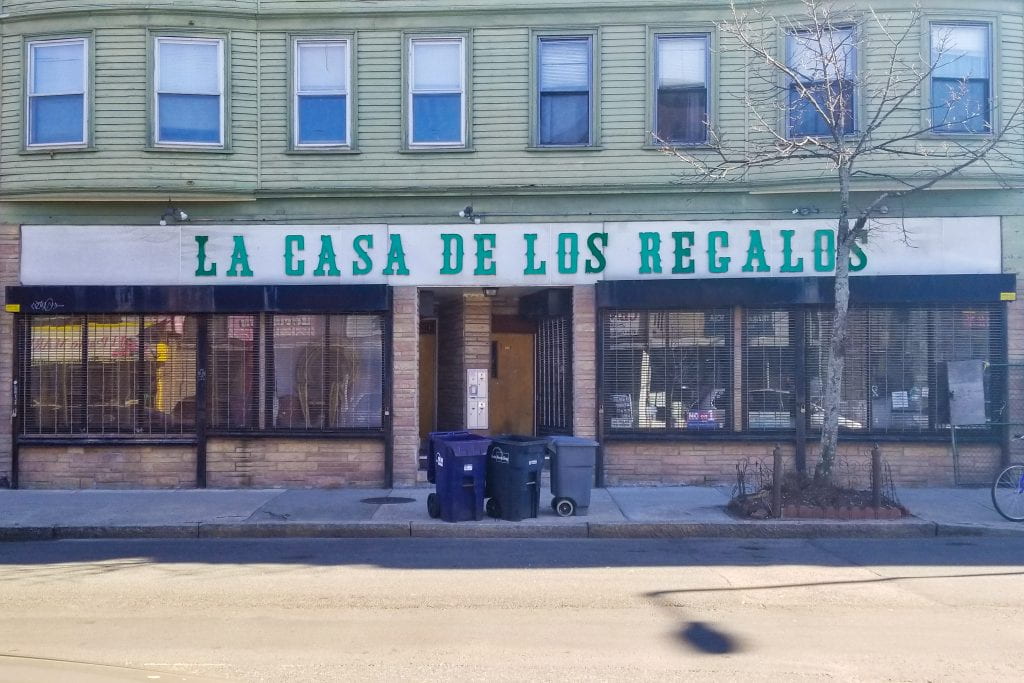Boston’s own little (tiny) Havana

By Seamus McAvoy
BOSTON — “I’m just glad they survived.”
Phil Chiampa and his wife Toni Lyn have been coming to El Oriental de Cuba for decades, but they worried they may have lost “the best Cuban food that we’ve ever had” when an arsonist set fire to the restaurant in 2005. Fourteen years later, the midday rush has filled El Oriental nearly to capacity, and the couple eagerly await their lunch at a small wooden table beneath a wall decorated with awards and raving newspaper reviews.
Meals like this at El Oriental have become regular for the Chiampas — they currently live in Cape Cod, but have owned property in Jamaica Plain since 1998. Business occasionally brings them into the city, and the couple routinely stops by for a bite to eat, or even just to say hello to the workers whom they’ve come to know over the years.
“We even went to Miami Beach and tried a restaurant there, but it wasn’t as good,” said Toni Lyn Chiampa, who prefers the shrimp with garlic sauce dish.
Nearly 1,500 miles separate the cities of Boston and Havana and yet, tucked away in a three-block cluster in Jamaica Plain, El Oriental and The Old Havana Cuban Restaurant bring Cuban cuisine to customers from all backgrounds. Mr V Auto Supplies and La Casa De Los Regalos are also easily spotted off Centre Street between the two restaurants, and together, this handful of businesses represent the remnants of the area’s once-vibrant Cuban community.
Residents of Hispanic or Latino descent compose 19 percent of Jamaica Plain’s population, per the 2016 American Community Survey conducted by the U.S. Census Bureau. However, locals say that the Cuban population has fallen since its peak in the 1960s and 1970s when those fleeing after Fidel Castro’s armed revolt in 1959 purchased property vacated by Irish and Italian immigrants.
Even so, in between a Whole Foods and an upscale coffee spot all added within the last eight years, the quartet of Cuban businesses stand a mere three blocks apart on Centre Street and have been serving the people of Jamaica Plain for nearly 30 years.
El Oriental de Cuba
Fiallo came to the United States in 1968 when he was 7 years old. He grew up in New York City before exploring other parts of the country, eventually settling in Boston while somehow avoiding the magnetism that Miami has for so many Cuban immigrants.
“All Cubans migrate to Miami at some point,” said Fiallo. “I lived in Miami for a while — wasn’t my thing. It’s nice, but honestly in Miami you don’t make money.”
In Boston, Fiallo and his family have fared well enough. In 1976, his uncle opened the first Cuban restaurant in Jamaica Plain called “La Española,” a small building across the street from present-day Whole Foods, and ran it for about 20 years before closing it down and moving to Miami. Fiallo says that the business was good — the line of people waiting for a seat would stretch outside and wrap around the corner, even in the winter.
Despite his uncle’s successes in the industry, as well as his love of food and cooking, Fiallo had never worked in a restaurant before joining Nobel Garcia’s staff at El Oriental. Fiallo and Garcia’s relationship spans decades — Garcia left Cuba in 1956 at the age of 8 to join his parents in Jamaica Plain, and today lives in the same house.
Garcia worked in Jamaica Plain at the convenience store his parents opened in the 1970s for 17 years before they closed down and retired to Miami. After spending a couple years at a paper mill in Framingham, Garcia returned to Jamaica Plain to work for his uncle, Evaristo Cambara, who in 1992 opened El Oriental.
“They were selling soups, white rice, black beans, Cuban sandwiches and the smoothies,” Garcia said. “That’s all there was.”
Garcia purchased El Oriental in 2000 once his uncle retired, and a lot has changed since. The restaurant’s menu has expanded to include a wide range of breakfast options, seafood, steak and a variety of other international fare. But the smoothies — including guava, mango and papaya — remain the biggest hit. Garcia has also overseen the expansion of the property itself as the restaurant’s capacity has grown from just 19 to 49.
He has also had a hand in some of El Oriental’s decor. Inside, innumerable pictures of Garcia with friends, family, local athletes and celebrities line the walls in concert with maps and photographs of Cuba, Cuban art and of course, a portrait of José Martí, an influential Cuban poet and revolutionary. Garcia is particularly proud of a photograph with his family and Tom Menino, the former mayor of Boston, and gets up from the table to ask one of his customers to take it off of the wall.
“We had a very unfortunate fire in 2005,” said Garcia, “and I am very grateful to the city of Boston, because they helped me re-open again.”
Just five years into Garcia’s ownership of El Oriental, an arsonist set fire to the property by throwing a Molotov cocktail-variant into the restaurant, causing a reported $400,000 in damages. The crime went unsolved until 2014, when the Major Case Unit of the Boston Fire Department pinned the arson on Jose Baez, who is currently serving a 15-year prison sentence. Baez pleaded guilty to four counts of arson in 2012 including the one at El Oriental, which he allegedly set as revenge for being served a bad meal.
The fire sent shockwaves through the community, and for 14 months the people of Jamaica Plain were without the iconic landmark that served the neighborhood’s residents and a small number of local Cubans. If Boston was not already home for Garcia, who had lived there for over 50 years, the incredible response to the tragedy solidified it as such. While El Oriental was rebuilt, Garcia was able to keep the catering business afloat thanks to public kitchens overseen by the Health Department set up for businesses that burned down or start-ups. The City of Boston also supplied Garcia with a pair of grants totaling $27,000 to rebuild.
Other local businesses did all that they could to ease the burden. They helped the restaurant’s staff members find jobs in other restaurants, and all 12 came back to El Oriental once it reopened. JP Seafood Cafe wrote Garcia a check for the sales made the Monday after the fire, worth $5,800, and Sorella’s, a cafe down the block that has been a Jamaica Plain fixture for 36 years, loaned him their kitchen in the interim.
It was a triumphant return.
“When we reopened, [the city] closed the whole [Centre Street] down, they diverted the traffic to South Huntington,” said Garcia. “We had a live band, we cooked for about 500 people, and everybody ate free that day. We are very fortunate to be here.”
Mr. V Auto Accessories
Garcia and Fiallo estimate that only about 20 percent of their present-day clientele is comprised of Cubans, whereas those numbers used to be roughly between 50 to 60 percent in the 1960s and 1970s.
Eduardo Vasallo, a now-retired Cuban businessman and owner of Mr. V Auto Accessories, attributes those changes to a migration of older Cubans to Miami. “They like to feel like they are in Cuba, because Miami is like Cuba, but modern,” said Vasallo, 75. “That’s a mostly Cuban thing; after you retire you want to go back to Miami and feel like you are like in warm weather and the atmosphere is like Cuba, the music, the restaurants.”
Vasallo managed to flee Cuba in 1962, just three years into Fidel Castro’s regime, at the age of 17, but was forced to leave his family behind. He found work through Miami’s Cuban Refugee Center before moving to Boston in 1963 where he worked at Beth Israel Hospital, cleaning floors to eventually have the money to send a boat to bring his family to the United States.
But things didn’t go according to plan. The boat broke down upon arriving in Cuba, and Vasallo’s mother was imprisoned for five years for attempting to escape. She later made it to the United States as a political exile, and his father and sister arrived through the 1980 Mariel boatlift, a mass emigration of Cubans to the United States.
His family has since found success in Boston. Vasallo pointed to a number of buildings he owns on Centre Street, like the one across the block from his auto parts place, Pimental Market, a Dominican grocery store. And Vasallo’s brother, Alberto, owns El Mundo Boston, one of New England’s largest Latino newspapers which has been in circulation for 46 years.
“I didn’t went to college or anything like that, I went to sixth grade in Cuba, that’s all I went,” said Vasallo. “To get to college or high school to college, I would have had to belong to the Young Communist Kids and I said ‘no, you’re not going to be a communist kid.’”

Even though Vasallo says that he’s retired, he still spends time checking in at Mr V Auto Accessories, now in the hands of his son Eddie, and finds work constructing awnings and signs similar to the bright orange one at Pimentel Market. He also finds opportunities to drop in to The Old Havana Cuban Restaurant to check-in with his friends and cousin, Sixto Lopez.
The Old Havana Cuban Restaurant
Lopez ran Vasallo Men’s Fashion (today Centre Fashion) after Vasallo opened his auto parts store in the building next door, and in 2013 opened Old Havana with the help of his wife. Lopez, who left Cuba in 1986 as a 36-year-old, has been around Jamaica Plain long enough to notice the change in Cuban population over the years. He says that roughly 80 percent of his customers are American while the rest are composed of some mix of Cubans, Hispanics and Asians.
“There are not too many Cubans around here, there are only three businesses around here that are from Cubans,” Lopez said. “But I’ve never had a problem with the other communities.”
Lopez says that he has had to tailor his menu to a more diverse clientele, but can still spot Cubans even if they were born in the United States and speak perfect English.
“For example, when they say ‘I want a Jupiña,’ that’s a kind of soda people in Cuba drink a lot, I know they are coming from Cubans,” said Lopez.
Though Lopez says that he wouldn’t want to visit Cuba under the current government, the Old Havana is alive with the look and feel of his home island. A photograph of the National Capitol Building in Havana decorates the front of the menu, which features classic Cuban dishes like ropa vieja, Cuban sandwiches and espresso-style cafe cubano. The walls are vibrant orange, and the wall behind the front counter is covered in a painting of a typical Havanan street with pastel-colored buildings of Spanish-architecture and the Malecon, an ocean-side strip, visible in the background.
The Old Havana is 23 years younger than El Oriental, and even as Lopez, now 69, gets older, he’s hesitant to think too far ahead.
“I’ll think about [the future] when I’m old,” Lopez says. “[I’ll move] to Miami, or something like that.”
For now, even while much of his family waits for him in Miami (his children, now adults, siblings and some cousins live there today), Lopez is focused on business at Old Havana, tending to the kitchen as he has since it opened while his wife runs the front end.
Today’s Jamaica Plain
Through the padlocked iron gates that more often than not cover the exterior of La Casa De Los Regalos, one can make out a rocking chair in the corner of the room, currently unoccupied. This wasn’t always the case — for years, Aida Lopez could usually be found presiding over the gift shop that she’s owned since the early 1970s, and today her absence is just one indication of the changing times in Jamaica Plain.
While the flag of Cuba no longer hangs in the window, some decorations remain. One flyer reads “Stop the U.S. war against Cuba,” and another calls for “Freedom for Cuba’s Prisoners of Conscience” with headshots, occupations and prison sentences of about 20 men listed below. Also pictured are photographs of palm trees as well as Pope Francis, who visited the island in 2015.
In Havana, modernity has taken its toll on the once-stunning, richly colored buildings that populate the city. The pastel colors have begun to fade as the icons of Spanish architecture wear down. La Casa De Los Regalos represents a similar transition, and the easily spotted green-on-white sign above the building no longer radiates quite the way it used to.
Centre Street itself looks much different today than it did when the influx of Cuban immigrants arrived — large companies like Whole Foods, Dunkin’ Donuts and Boost Mobile now have locations in the same three-block stretch as the quartet of Cuban businesses, but one can also find an Ethiopian cafe adjacent to a Dominican restaurant simply by standing outside La Casa De Los Regalos.
As for the future of El Oriental, Garcia says he plans on running things for a few more years before selling it to Fiallo.
“He’s my No. 1 pick,” he said. “I have other offers and things like that, I have a whole book upstairs of people.”
Garcia says he would consider selling to a non-Cuban, but would rather see the legacy of El Oriental continue under the leadership of Fiallo, the only other Cuban on staff. The restaurant has hardly strayed from its roots over its nearly 30 years in business, and should Fiallo own El Oriental someday, that trend would likely continue.
Well, for the most part. “I would probably take some things out of the menu that we have that doesn’t sell that much, like I’m just looking at it now,” Fiallo says as he glances at the daily specials. “Beef tongue!”
